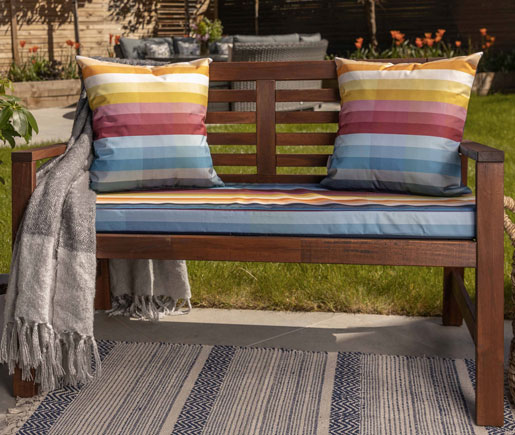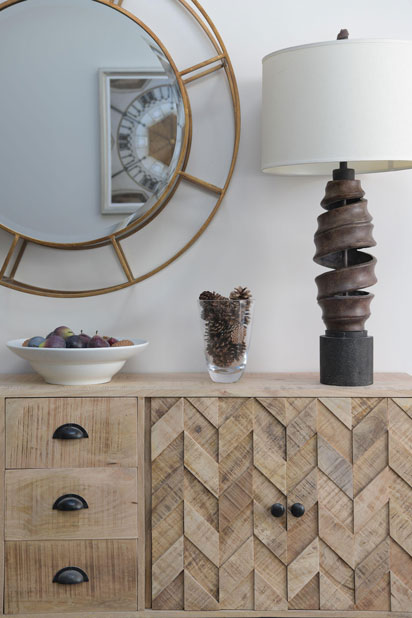These fine lines and broad strokes are grabbing our attention this season, says Sam Wylie-Harris.
There are stripes, and then there are stripes.
The kind that knock you for six with their snazzy colour combinations, some that look sharp, and fun pieces that bring a room to life with their circus stripes.
Either way, stripes make a statement, love the limelight, draw the eye in and, depending on how you use them, are a clever tool and timeless look.
Vertical stripes create an illusion of height, while horizontal stripes make everything look wider.
Wondering where to start? These appealing colourways are easy to live with and fit most schemes…

1. Oliver Bonas Azur Wiggle Stripe Platter, £49.50, rest of items from a selection, Oliver Bonas – available mid-March
Bold stripes have that knack of making everything look bang up to date, especially in chunky stoneware, teamed with colourful glassware, striped placemats and trendy squiggles.

2. The Small Stripy Terracotta Vase, £23, The Happy Blossoms
This playful vase with clashing colours looks groovy before you’ve even filled it with bright blooms.

3. Market Stripe Cerise Oil Cloth, £37, Bluebellgray
If you’re thinking warmer weather, braving the BBQ and tantalising tablescaping to accommodate all those marinades and weekend brunches, this oil cloth tablecloth can cope with any spills, and makes a sunny statement.

4. Kintaro Pitcher – Indigo, £40, OKA
Classic stripes fit country-kitchen style, as well as neutral décor and seaside views.

5. Dakarai Spice Roman Blind, from £37.75, Blinds-2-Go
A budget-friendly update that’s ‘pane’ free and easy to fit, stylish stripes with hints of warm spice work just as well with contrasting colours or complementary shades.

6. Candy Stripe Cheese Knives, £27.50, Oliver Bonas
Little touches like candy stripe cheese knives make a joyous addition to mealtimes, and this trio can be themed to a cheese and wine party.

7. Velvet Stripe Cushion, £20, Next
Dreamy in tangerine and blush pink, even if you’re not big on stripes, who wouldn’t be smitten with one of these on their sofa?

8. ‘Stripes’ White and Blue Wallpaper, £60 per roll, Paper Boy Wallpaper
When more is more, we love this graffiti spray stripe, which can be enhanced with corresponding cushions and other navy and white decorative pieces.

9. Kaikoo Cream & Black Stripe Woven Pouffe, £45, Direct.asda
Versatile and useful, this pouffe in smart black stripes doubles up as a spare seat, foot rest, and place to rest a tray or magazines.

10. Bonne Nuit Pastel French Art Print, from £41.95 (21 x 30cm), Framed and Mounted, Abstract House
Who says stripes can’t be soothing or make you sleepy?

11. Carnaby Stripe Towels in Blue, Neutral, Multi and Berry, from £11.20-£30.40, Christy
An easy way to jazz up a bathroom, this striped towel collection could be mistaken for Missoni without the designer price tag.

12. Green Striped Wooden Deck Chair with Head Cushion, £149.99, Gardenesque
Channelling some boho chic with its fringed hem and comfy head cushion, this mint green deck chair is destined to be a hit and would look just as lovely in a sun room or conservatory, as it would a manicured lawn. An added bonus, it folds down flat for that long-awaited jaunt to the seaside.

13. Water Resistant Garden Outdoor Bench Seat Pad – Pixel Stripes (available in 2-Seater or 3-Seater size), from £69.99, Water Resistant Garden Cushions, £29.99 each, Celina Digby
Another easy update, especially if your garden furniture’s looking a little tired or weathered. Water resistant and perfect for al fresco dining, this seat pad and matching cushions look divine placed near geraniums and hydrangeas.










